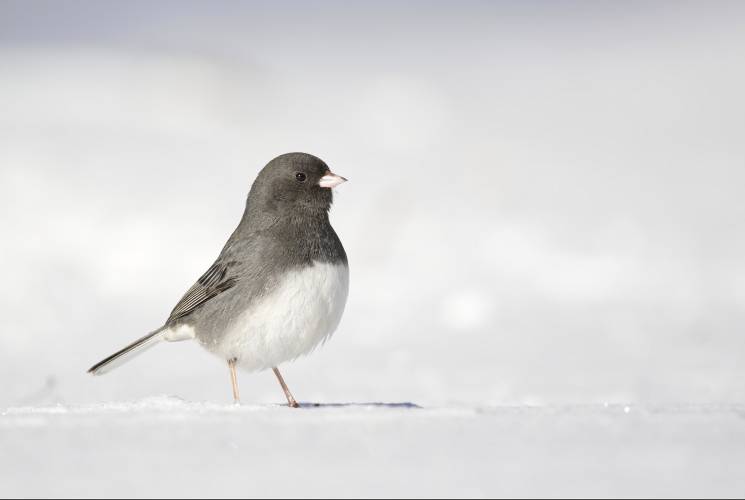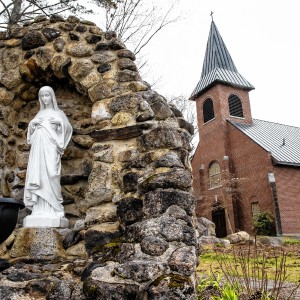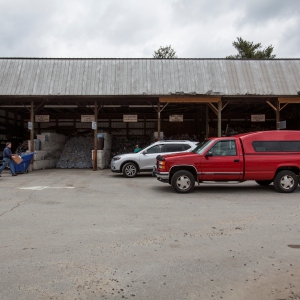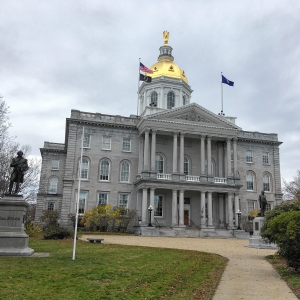Take Me Outside: Birrrrds – how do they keep warm?

The dark-eyed junco, one of the most common forest birds in North America, is among species likely to be spotted by participants in the Great Backyard Bird Watch, running Feb. 17-20. Rowan Keunen / Macaulay Library – Cornell Lab of Ornithology
| Published: 01-28-2024 6:00 AM |
By RUTH SMITH
For the Monitor
I watched the snow gently fall from the warmth of my woodstove-heated living room. Outside on the ground dark-eyed juncos hopped about, scratching through the fresh drifts. On branches above, mourning doves were perched and puffed up, looking like dried beech leaves. Through the air woodpeckers darted back and forth, taking turns at the suet block. I kept thinking, how do they keep warm in the midst of a snowstorm, or at any point during the cold winter months?
Watching birds provides some of the answers. The juncos and woodpeckers were ingesting food. Songbirds have a high metabolism and body temperature, so they must eat a lot. The fuel for their body is like the wood for my stove. The more I stuff in, the hotter it burns. To keep their hot little fires burning, birds need to gorge themselves.
Black-capped chickadees for example have to maintain a body temperature of 100 degrees. They do this by eating 35% of their body weight each day. When you weigh less than half an ounce, that may not seem like much. Translate that to what a 150-pound person would need to eat – 52 pounds of food per day. No thanks! This is one reason why bird feeders can be helpful for our feathered friends in winter. It’s not that they couldn’t survive without us, it just makes their consumption more efficient: easy picking for tanking up and meeting their caloric needs.
If you watch birds at feeders, you have probably noticed that they don’t all feed the same way. American goldfinches sit at the feeder and eat one seed after another, cracking open the seeds between their beaks. At our house they are affectionately known as “pig birds”. They don’t waste energy flying back and forth unless someone comes along to nudge them off the perch.
Chickadees in contrast, flit in, snatch a seed, and quickly exit to a branch. There they hold the seed with their feet and peck at the shell to extract the kernel inside. Or they may take the seed and hide it for later. Storing food is another trick for ensuring that they have enough when the days are cold. The chickadee has an extra-large hippocampus which is the part of the brain that is responsible for spatial memory. Chances are good they will find the hidden food when they need it.
Another adaptation which helps keep their body temperature up is insulation. Birds have built-in down jackets. Contour and flight feathers provide the colors which we see and the outer protective layer of feathers. Downy feathers underneath are soft and fluffy, providing plenty of air space for trapping and holding body heat. When it’s particularly cold, birds may puff up their feathers, creating even more space for maintaining warm air. This is what the mourning doves were doing.
Article continues after...
Yesterday's Most Read Articles
 UNH faculty and students call on university police chief to resign following his alleged assault on a student
UNH faculty and students call on university police chief to resign following his alleged assault on a student
 Steeplegate project to reopen to public comment as developer seeks to reduce required parking
Steeplegate project to reopen to public comment as developer seeks to reduce required parking
 Opinion: NH should support SB 553
Opinion: NH should support SB 553
 A turbulent 50-year history: Inside the rise and fall of a tiny Catholic college in Warner
A turbulent 50-year history: Inside the rise and fall of a tiny Catholic college in Warner
 Hopkinton tries to nab out-of-town trash bandits
Hopkinton tries to nab out-of-town trash bandits
 Lawyers and lawmakers assert the Department of Education is on the verge of violating the law
Lawyers and lawmakers assert the Department of Education is on the verge of violating the law
That all works well for the feathered parts of their bodies, but what about their legs, feet, and beaks? Birds that live in northern latitudes tend to have smaller beaks than those in warmer areas. The smaller surface area reduces heat loss. When roosting or perching in the cold, birds will often tuck their heads under their wings to warm their beaks.
For standing birds, pulling one foot at a time into their feathers works, or in the case of a perching bird, sitting on their feet, provides a feathery covering for those bare appendages. The other amazing thing about bird feet is the pattern of rapid blood circulation called countercurrent heat exchange. Blood vessels going out to the toes and back to the body are very close together. Warm blood flowing out passes the cold blood coming back. The cooled blood in the toes lowers heat loss through the feet. Warmed blood coming back to the body decreases the chilling impact on the bird.
The most dramatic heat saving adaptation happens at night when some birds drop their body temperature and enter a period of torpor. Gathering in groups in an evergreen shrub or tree or huddling in a tree cavity also helps consolidate warmth.
Even knowing all of these techniques, I still marvel when I see the birds in winter and am even more grateful for my wood stove.


 Northeast Coffee Festival comes to Concord this weekend
Northeast Coffee Festival comes to Concord this weekend Henniker Handmade & Homegrown
Henniker Handmade & Homegrown Colonial Theatre Laconia presents Piff the Magic Dragon
Colonial Theatre Laconia presents Piff the Magic Dragon The Loft at Hermit Woods presents Pete Kilpatrick
The Loft at Hermit Woods presents Pete Kilpatrick 
